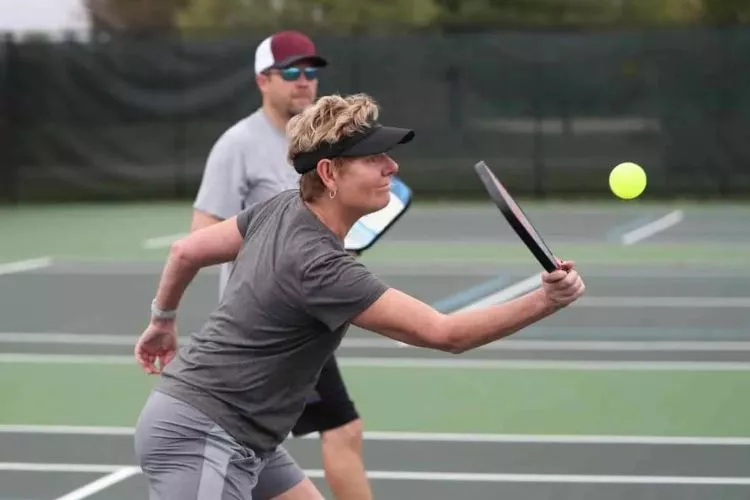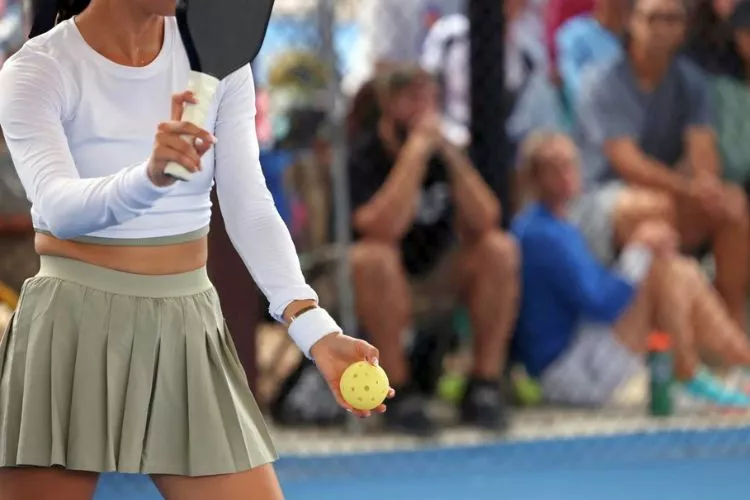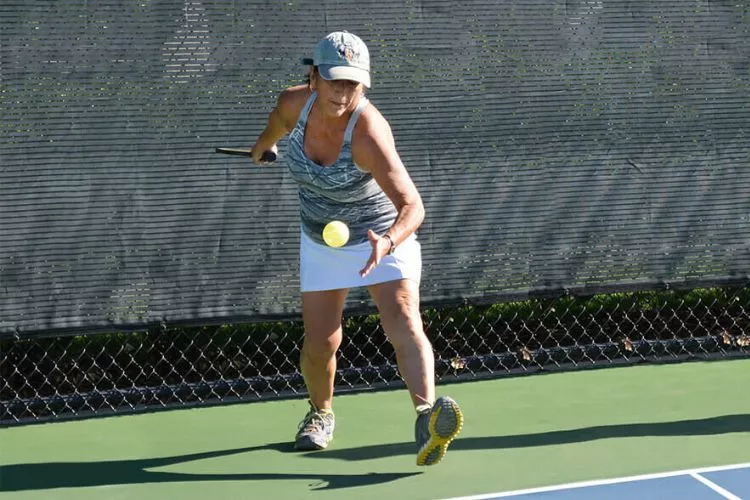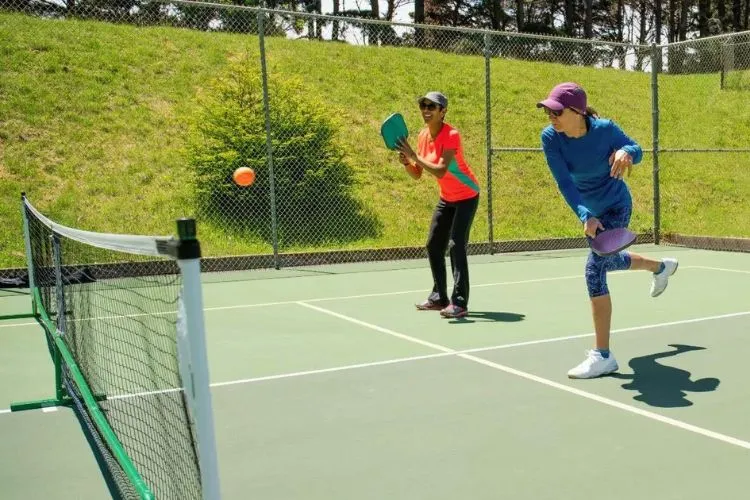Serving is a crucial aspect of pickleball. It sets the game in motion and can have a significant impact on the outcome.
However, there is often confusion about whether it is permissible to serve overhand in pickleball.
So, can you serve overhand in pickleball?
In this article, we will dive into the rules, techniques, and strategies surrounding pickleball serves, particularly focusing on the controversial topic of serving overhand.

Can you serve overhand in pickleball? (The Truth)
No, serving overhand is not allowed in pickleball. The official rules state that the serve must be made underhand, with the server keeping both feet behind the baseline until after the ball is struck.
Serving overhand can result in penalties, such as loss of serve or side out. It is important to adhere to the underhand serve technique to maintain fair play and the integrity of the game.
Pickleball Serve Rules

The Official Rulebook
The USA Pickleball Rules clearly state that the serve must be made underhand. According to Rule 4.C.1, “The server must keep both feet behind the baseline until after the ball is struck.”
This means that an overhand serve, where the player’s hand is above their waist at the point of contact, is considered illegal in pickleball.
Penalties for serving overhand can result in the loss of the serve, side out, or even forfeiture of the game. It is essential to understand and adhere to the official rules to ensure fair play and maintain the integrity of the game.
Clarifying Common Misconceptions
One common misconception is that serving overhand is allowed in pickleball, as it is in other racket sports like tennis. However, pickleball has its own unique set of rules, and the underhand serve requirement is one of them.
The underhand serve has become the standard in pickleball due to the emphasis on maintaining a level playing field and promoting inclusivity. It ensures that players of all ages and skill levels can participate and enjoy the game without feeling disadvantaged.
Serving Techniques: Underhand vs Overhand
Underhand Serve Technique

The underhand serve is the accepted and preferred technique in pickleball. Here’s a breakdown of the proper underhand serve technique:
- Grip: Start by gripping the paddle comfortably.
- Stance: Position yourself behind the baseline with your feet shoulder-width apart.
- Swing motion: Swing the paddle using an upward motion, making contact with the ball below waist height.
- Follow-through: Allow your arm to naturally follow through after striking the ball, maintaining balance and control.
Advantages of Underhand Serves
The underhand serve offers several advantages:
- Greater control over ball placement.
- Easier to generate spin and vary the speed.
- Reduced risk of excessive power, resulting in more accurate serves.
- Improved consistency and reliability compared to overhand serves.
Pro Tips for Underhand Serves
- Practice precision: Focus on hitting specific target areas on the pickleball court during practice sessions.
- Spin variations: Experiment with different spins (topspin, backspin, or sidespin) to add complexity to your serves and make them harder for opponents to return.
- Vary the speed: Mix up the speed of your serves to keep opponents guessing and off balance.
Why Overhand Serves Are Not Allowed in Pickleball?
Pickleball’s rules prioritize a different style of play, focusing on finesse, positioning, and strategy rather than power.
Allowing overhand serves could tilt the game too heavily towards power-based playing styles, potentially reducing the accessibility and enjoyment for players of varying skill levels.
Strategies for Effective Pickleball Serves

Placement Over Power
When it comes to pickleball serves, precise placement is often more important than raw power. Instead of aiming for an overpowering serve, strive for strategic placement to put your opponents on the defensive from the start.
Consider these target areas on the pickleball court:
- Deep serve to the baseline to push opponents back.
- Short serve to the kitchen line (NVZ), preventing opponents from charging the net.
- Sideline serves to catch opponents off guard and limit their shot options.
Spin and Speed Variations
Adding spin and varying the speed of your serves can significantly impact the outcome of the game. Here are some techniques to consider:
- Spin:
- Topspin: Generates a downward trajectory, forcing opponents to hit the ball up, making it easier to attack.
- Backspin: Lifts the ball slightly, causing opponents to hit it higher, potentially leading to weaker returns.
- Sidespin: Creates lateral movement, making it challenging for opponents to predict the ball’s trajectory.
- Speed:
- Fast serves create pressure and limit reaction time for opponents.
- Slower, well-placed serves can catch opponents off-guard and disrupt their rhythm.
Deception Tactics
Adding deception to your serves can give you a crucial advantage. By disguising your serve intentions, you can keep opponents guessing and prevent them from anticipating your shots. Here are some tips:
- Changing grip positions: Alter your grip slightly to create variation in your strokes, making it harder for opponents to anticipate your shot.
- Fake footwork: Use footwork as a deceptive tool by subtly adjusting your positioning before serving.
- Visual cues: Master the art of subtle body and paddle movements to mislead opponents.
Frequently Asked Questions (FAQs)
Can you serve overhand in pickleball for beginners?
No, the underhand serve is the official and mandatory serving technique in pickleball, regardless of skill level.
What are the consequences of an illegal serve in pickleball?
Illegal serves result in penalties, such as the loss of the serve, side out, or even forfeiture of the game.
Can you hit the line on a serve in pickleball?
Yes, hitting the line is considered inbounds in pickleball, both on serves and during rallies.
What are the 5 serving rules in pickleball?
The serving rules in pickleball pertain to the underhand serve technique, foot positioning, keeping both feet behind the baseline, and striking the ball below waist height.
Conclusion:
While serving overhand is not allowed in pickleball, the underhand serve remains a significant aspect of the game.
By understanding the rules, mastering the underhand serve technique, and incorporating strategic serving strategies, you can become a formidable opponent on the pickleball court.
Remember, practice makes perfect, so dedicate time to refine your serve skills and enjoy the exciting sport of pickleball to the fullest.

Pickleball’s more than a game to me—it’s a passion. I write, sharing its highs and lows, the thrills and the lessons. Some tales might draw you to the court, while others give a hint of the game’s magic. So, curious about my journey? Ready to dive deep into the world of pickleball with me? Let’s go.
